|
Getting your Trinity Audio player ready...
|
Have you ever wondered what makes a successful PPC advertising campaign? With so many businesses vying for attention online, how can you make sure your ads stand out? Learning from the best is a great way to start.
PPC (pay-per-click) advertising is a popular way for businesses to reach their target audience online. It involves placing paid ads on search engines and social media platforms, and only paying when someone clicks on the ad.
However, not all PPC campaigns are created equal, and some examples stand out from the crowd for their effectiveness.
If you’re looking to create a successful PPC advertising campaign, it’s essential to understand what works and what doesn’t. By analyzing some of the best PPC campaigns out there, you can gain valuable insights into what makes a winning strategy.
In this article, we’ll take a closer look at some of the most successful PPC advertising campaign examples and explore what made them so effective.
PPC (Pay-per-click)
PPC stands for pay-per-click, a model of digital advertising where the advertiser pays a fee each time one of their ads is clicked.
Understanding the Benefits of PPC Advertising for Business Campaigns
PPC advertising, as the name suggests, is a model in which advertisers pay a fee each time their ad is clicked. This advertising approach offers several notable benefits for your business, allowing you to reach your target audience effectively and drive meaningful results.
Let’s explore some of the key benefits of PPC advertising for business campaigns:
1. Immediate Visibility and Increased Website Traffic
PPC advertising allows you to instantly appear at the top of search engine results pages, ensuring maximum visibility for your business. With well-crafted ad campaigns and targeted keywords, you can drive a significant amount of traffic to your website, increasing the chances of conversions and sales.
Google’s economic impact statistics show that businesses earn an average of $2 for every $1 spent on Google Ads, emphasizing the effectiveness of PPC advertising in driving quality traffic and generating a positive return on investment.
2. Targeted Advertising and Audience Reach
One of the most significant advantages of PPC advertising is the ability to target specific demographics, locations, and interests. You have precise control over who sees your ads, ensuring that your message reaches the most relevant audience.
For example, if you own a local bakery, you can target your PPC campaigns to appear only to users in your area who are searching for keywords related to bakery products or services. This level of targeting helps you maximize your advertising budget by focusing on the audience most likely to convert into customers.
3. Cost Control and Budget Flexibility
With PPC advertising, you have full control over your budget and can set daily or monthly spending limits. This flexibility allows you to allocate your advertising budget according to your business goals and needs.
Additionally, PPC campaigns operate on a pay-per-click basis, meaning you only pay when someone clicks on your ad. This model ensures that you’re paying for actual engagement with your brand, making it a cost-effective advertising option.
4. Measurable Results and Data-Driven Insights
PPC advertising provides comprehensive analytics and tracking tools, allowing you to measure the performance of your campaigns accurately. You can gather valuable data on impressions, clicks, conversions, and other key metrics to evaluate the success of your ads.
This data-driven approach empowers you to make informed decisions about your advertising strategies, refine your campaigns, and optimize your budget allocation for maximum ROI.
By continuously monitoring and analyzing campaign performance, you can identify areas of improvement and take proactive steps to enhance your results.
5. Flexibility for Testing and Optimization
Another benefit of PPC advertising is the ability to test different ad variations, headlines, keywords, and landing page designs. Through A/B testing and experimentation, you can identify the most effective elements and optimize your campaigns for better results.
For instance, you can create multiple ad variations with different headlines and calls-to-action to see which ones resonate best with your audience. By analyzing the performance of each variation, you can refine your ads to achieve higher click-through rates and conversion rates over time.
6. Enhanced Brand Awareness and Exposure
PPC advertising not only drives immediate traffic and conversions but also enhances brand awareness and exposure. When your ads consistently appear at the top of search results, users become more familiar with your brand, leading to increased brand recognition and recall.
Even if users don’t click on your ads initially, the repeated exposure can leave a lasting impression and prompt them to engage with your brand in the future.
This top-of-mind awareness contributes to building a strong brand presence and establishing your business as a trusted authority in your industry.
Effective Strategies for Successful Business Campaigns
To run successful PPC advertising campaigns, it’s important to implement effective strategies that align with your business goals and target audience. Here are some key strategies to consider:
1. Comprehensive Keyword Research and Selection
One of the foundational elements of a successful PPC campaign is comprehensive keyword research and selection. By identifying high-converting keywords that are relevant to your business, you can ensure that your ads are shown to users actively searching for the products or services you offer.
Use keyword research tools and techniques to uncover valuable keywords with high search volume and lower competition. This enables you to optimize your campaign for maximum visibility and relevance.
2. Compelling Ad Copy and Creative
Crafting compelling ad copy and creativity is essential for capturing the attention of your audience and driving engagement.
Your ad should communicate a clear value proposition, highlight unique selling points, and compel users to take action. Incorporate persuasive language, compelling visuals, and strong calls-to-action (CTAs) to maximize engagement and conversions.
Remember, a well-crafted ad that stands out from the competition can significantly impact the performance of your campaign.
3. Targeting and Audience Segmentation
Segmenting your target audience and customizing your campaigns based on their demographics, geographic location, and interests can significantly improve the performance of your PPC campaigns.
By tailoring your ads to specific audience segments, you can deliver more personalized and relevant messages, increasing the chances of engagement and conversions. Use the targeting options available on advertising platforms to narrow down your audience and ensure your ads are shown to the most relevant individuals.
4. Ad Testing and Optimization
Continuous testing and optimization are essential for maximizing the effectiveness of your PPC campaigns. Conduct A/B tests to compare different ad variations, such as different headlines, ad copy, or CTAs, and identify which performs better.
Analyze the results and make data-driven decisions to optimize your campaigns accordingly. By constantly monitoring and refining your ads, you can improve click-through rates, conversion rates, and overall campaign performance.
Inspiring PPC Advertising Business Campaign Examples
1. talkSPORT
talkSPORT, a popular sports radio station, successfully used PPC advertising to reach a wider audience and increase listenership.

talkSPORT, the prominent commercial broadcaster, enlisted the expertise of search agency Guava to enhance website traffic by introducing embeddable widgets with scrollable content.
Building upon their existing talkSPORT newsfeeds on renowned football news and rumour platforms, Guava aimed to create visually appealing and captivating widgets to present the content in an improved manner.
The newly developed embeddable newsfeed widgets were made available on talkSPORT’s website, empowering publishers to embed and customize each widget according to their audience’s preferences. This customization included options such as displaying exclusively Manchester United news for a more tailored experience.
One key differentiator was that the widgets were presented in a scrollable HTML format, departing from the traditional RSS feed. This deliberate choice contributed to capturing visitors’ attention more effectively.
The impact of these initiatives was remarkable. Before the launch of the widgets in April 2012, talkSPORT was receiving approximately 800,000 monthly visits from referring sites.
However, once the widgets went live and gained adoption across multiple platforms, website traffic soared. By the end of August, coinciding with the closure of the transfer window, the widgets were responsible for an impressive influx of 4 million monthly visitors.
This phenomenal growth translated into a staggering 400% increase within just four months.
As a bonus, Guava’s successful campaign propelled talkSPORT to the top of Google search results for the highly competitive keyword “transfer rumours,” further solidifying the broadcaster’s digital presence and visibility.
The collaboration between talkSPORT and Guava exemplifies how the strategic implementation of engaging widgets and interactive content can generate substantial increases in website traffic and overall brand exposure.
By leveraging these innovative approaches, talkSPORT successfully expanded its reach, capturing the attention of a wider audience and establishing its dominance in the online sports news landscape.
2. Converse “Conversations”
Converse’s “Conversations” PPC campaign stands out as a testament to its creativity and its remarkable effectiveness in capturing the attention of its target audience.

To boost online engagement with its teenage demographic, the renowned footwear brand partnered with marketing agency Anomaly to devise an innovative and entertaining approach. Rather than immediately pushing their products, Converse aimed to tap into the cultural interests and conversations of their audience.
Extensive research and insights guided their strategy, which involved leveraging Google AdWords to identify and target search terms relevant to their prospective customers’ current interests.
Instead of using traditional ads, Converse initiated a dialogue with viewers through engaging ad copy and interconnected microsites. This approach allowed them to establish a connection and deliver a content-rich experience that went beyond mere advertising.
The campaign utilized a variety of keywords to spark interest and generate meaningful interactions, such as “First day of summer,” “Spelling bee,” “How to talk to girls,” and “How to kiss.” By immersing themselves in these cultural moments and providing helpful information, Converse effectively drew users into a deeper engagement with their brand.
The “Conversations” campaign exemplifies Converse’s commitment to being a part of their audience’s lives and fostering authentic connections.
By prioritizing meaningful interactions over direct sales pitches, Converse successfully captured the attention and loyalty of their target demographic, ultimately driving them back to the Converse brand.
3. BP Oil’s Slippy Experience
When BP Oil faced a significant reputation crisis following the infamous oil spill, they leveraged PPC advertising to address the issue head-on.
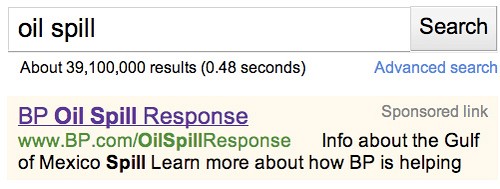
BP Oil’s “Slippy Experience” campaign, while delivering successful results in terms of visibility and positioning, ultimately became a case study of misguided brand communication, resulting in a PR disaster.
In the aftermath of the catastrophic oil spill in the Gulf of Mexico in 2010, BP attempted to salvage its tarnished brand reputation through the use of paid advertisements. They strategically bid on over 1000 search terms related to the “oil spill” to ensure prominent visibility, often securing the top position in search engine rankings.
By employing this approach, BP aimed to direct visitors to a dedicated page on their website called the “Gulf of Mexico Response homepage.” The purpose of this page was to transparently communicate their ongoing efforts to address the environmental disaster and explain the steps they were taking for recovery.
However, despite their efforts, BP’s communication strategy faltered when it came to the tone and voice used in their ads and website content. Instead of connecting with the public on a personal and empathetic level, BP’s messaging appeared to be crafted by corporate lawyers, resulting in a jargon-filled and impersonal sentence that lacked genuine humanity.
This missed opportunity to engage with the public on a more relatable level, acknowledging their fears and concerns, only reinforced the perception of BP as a soulless entity disconnected from the human impact of the oil spill.
The “Slippy Experience” campaign serves as a reminder that effective brand communication requires more than just visibility and positioning. It underscores the importance of speaking to the public with an authentic and empathetic voice, especially in times of crisis. By humanizing their messaging and addressing the concerns of the public, brands can foster a sense of trust and demonstrate their commitment to making amends.
4. Converse “Domination”
Converse once again demonstrated its PPC prowess with the “Domination” campaign. By strategically bidding on their competitors’ brand names as keywords, Converse effectively captured the attention of individuals searching for alternative shoe options.
Their engaging ad copy showcased the unique features and style of Converse shoes, enticing users to explore their offerings. This bold strategy enabled Converse to divert potential customers away from competitors and drive brand visibility, resulting in increased website visits, conversions, and ultimately, sales.
5. Snickers – You’re Not You When You’re Hungry
Snickers, the popular chocolate bar brand, launched a memorable PPC campaign centred around the slogan “You’re Not You When You’re Hungry.”
By bidding on relevant keywords related to hunger and common personality traits associated with hunger, Snickers created compelling ad copy and engaging visuals that resonated with users. The campaign humorously portrayed individuals acting out of character due to hunger and positioned Snickers as the solution to their hunger-induced behaviour.
This creative and memorable approach resulted in increased brand awareness, higher ad engagement, and a significant boost in Snickers’ sales.
Snickers, renowned for its memorable slogan “You’re Not You When You’re Hungry,” took an unconventional approach to PPC advertising by targeting misspelt search terms.
In collaboration with the AMV BBDO ad agency and Google, they embarked on a unique campaign that tapped into the vast potential of misspellings. Through a clever algorithm, they generated a comprehensive list of 25,381 different misspelt variations based on the top 500 search terms.
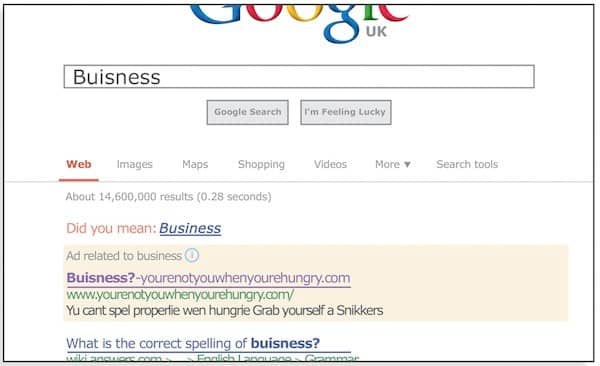
Jessica Langdell, representing AMV BBDO, shed light on some of the surprising misspellings that garnered substantial traffic for the Snickers campaign. These included terms like “weather,” “goal,” “ness,” “amazing,” “definitely,” “wierd,” “vacuum,” “moonsoon,” “publically,” and “facw.”
The results were impressive, with Snickers amassing 558,589 ad impressions within just two days. The campaign’s click-through rate stood at 1.05%, driving 5,874 visitors to the dedicated mini website, yourenotyouwhenyourehungry.com.
Snickers’ innovative use of misspelt search terms showcases their willingness to explore uncharted territories in the realm of PPC advertising.
By capitalizing on these linguistic errors, they were able to capture the attention of a wider audience and drive significant traffic to their campaign’s online platform. This daring strategy not only yielded impressive results but also sparked curiosity about the intricacies of ad approval within the digital advertising landscape.
6. Kleenex Catches Colds
The Kleenex Catches Colds campaign garnered significant recognition, earning the esteemed “Best Use of Digital Media in 2013” award. Developed by the ad experts at Mindshare, this campaign demonstrated a remarkable understanding of consumer behaviour and implemented an adaptive planning strategy that proved highly effective.
Mindshare astutely observed a shift in consumer behaviour, noting that when individuals experience cold or flu symptoms, they often turn to Google for information rather than immediately seeking medical advice.
Leveraging this valuable insight, Mindshare capitalized on the power of Google’s geographic targeting capabilities to precisely target cities across the nation experiencing flu outbreaks in real-time. This approach allowed them to focus their PPC campaign on the most relevant locations.
Over 18 months, Mindshare meticulously analyzed search trends related to colds and flu, comparing the data with other relevant sources such as calls to Government health lines and doctor visits.
Through this comprehensive analysis, they constructed a sophisticated model that enabled them to predict flu outbreaks at the city level, providing valuable insights in real-time.
The results of this campaign were truly remarkable. During the 2012 cold and flu season, an impressive 96% of Kleenex UK’s media spend was strategically allocated to regions of the country experiencing live flu outbreaks. This targeted approach yielded exceptional outcomes, with total sales witnessing a remarkable 40% year-on-year increase within the first two months alone.
The Kleenex Catches Colds campaign serves as a prime example of how strategic and data-driven PPC advertising, combined with an astute understanding of consumer behaviour, can yield exceptional results for brands. By leveraging real-time insights and adapting their campaign based on predictive models, Mindshare and Kleenex were able to effectively capture the attention of their target audience and drive substantial business growth.
7. Sky News
Sky News faced the unique challenge of effectively using paid search to target users searching for specific news stories.
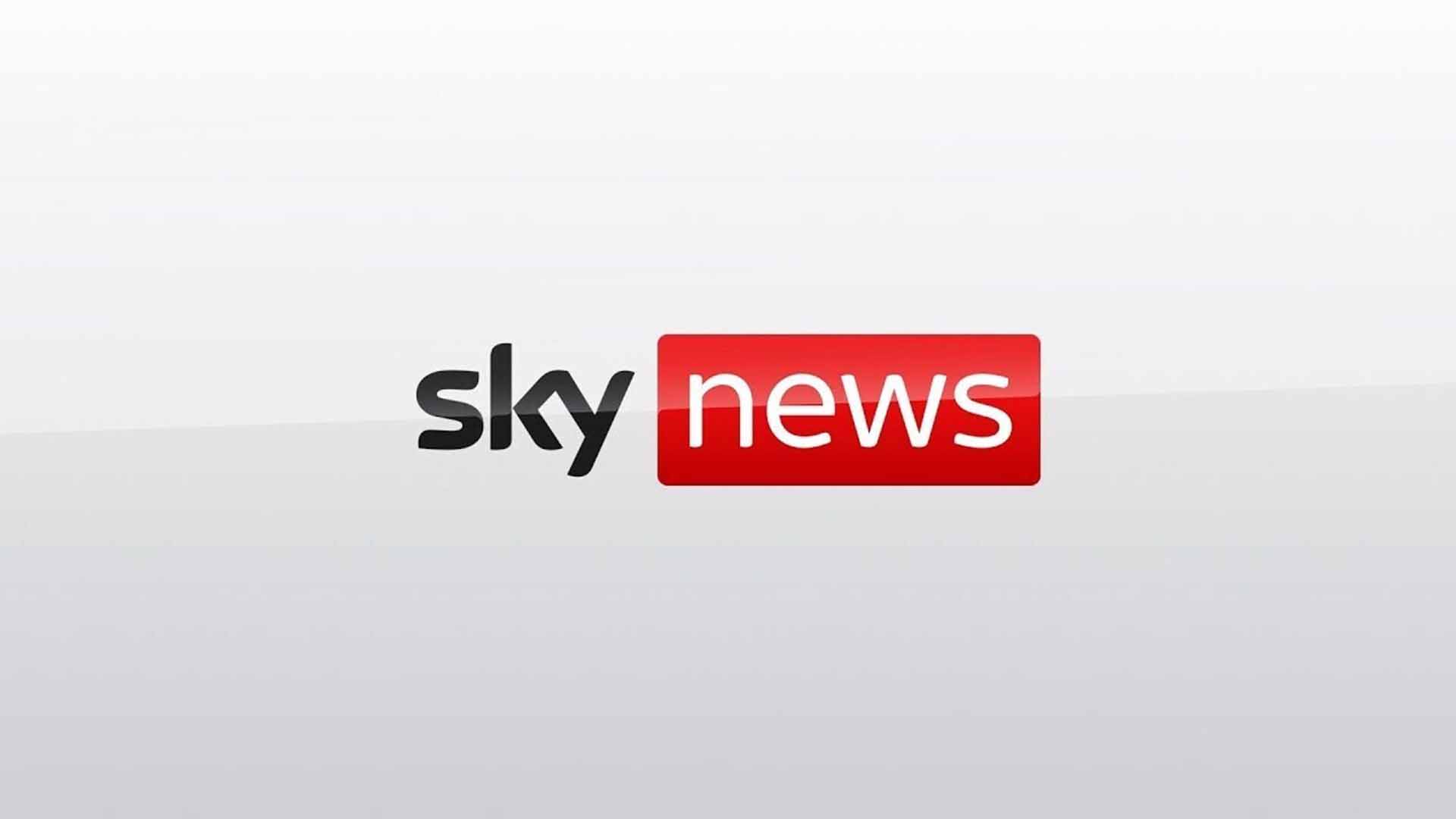
To overcome this hurdle and gain a competitive edge, Sky News partnered with Unique Digital, a leading digital marketing agency renowned for its innovative solutions. Leveraging Unique Digital’s Darwin Optimiser technology, they transformed Sky News’ RSS feed into a valuable resource for generating highly relevant keywords tied to specific news stories.
With a pre-determined PPC budget in place, the team could closely monitor and adjust their spending daily, especially during major news events when the demand for relevant content surged.
So, why was this approach successful?
The answer lies in the highly specific nature of the keywords generated. These keywords not only captured the attention of the target audience, but they also resulted in remarkably low costs per click (CPC). The campaign achieved over 100,000 clicks, all at a CPC of under 25p each.
By capitalizing on the power of targeted keywords and closely aligning its PPC budget with major news events, Sky News effectively reached its desired audience while maintaining cost efficiency. This strategic approach not only drove significant click volumes but also ensured that each click came at a reasonable cost.
8. Argos – Predictive Analytics in Performance Marketing
Argos, the renowned retailer, collaborated with Summit, a leading online marketing company, to create a groundbreaking PPC campaign that earned them the prestigious Search Awards in 2014.
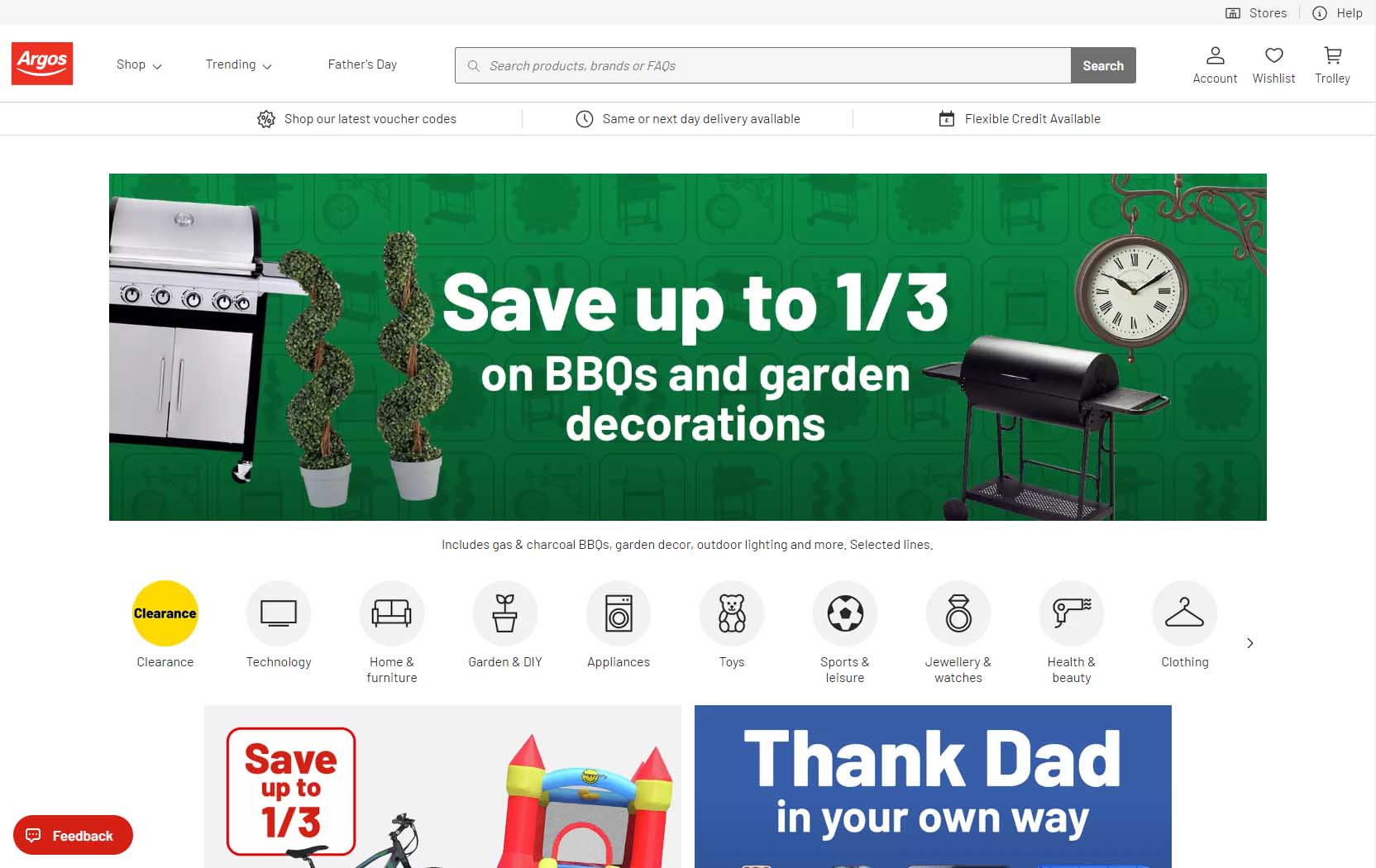
What made this campaign stand out was Summit’s innovative use of predictive analytics in performance marketing, enabling them to anticipate customer behaviour and make real-time adjustments to bids and ads.
What set Summit apart from its competitors was its comprehensive approach to data analysis. They leveraged various data sources, including weather patterns, television viewership, geographic location, and seasonal trends, to enhance the accuracy of their predictions.
By harnessing the power of predictive analytics, Argos was able to optimize its PPC campaigns, achieving remarkable sales records while effectively managing costs.

The integration of predictive analytics allowed Argos to stay one step ahead of customer preferences and market dynamics.
By tailoring their bidding strategies and ad placements based on data-driven insights, they could deliver targeted and highly relevant advertising to their audience, maximizing the impact of their PPC efforts.
This strategic collaboration between Argos and Summit exemplifies the immense potential of predictive analytics in driving performance marketing. By utilizing advanced data analytics techniques and incorporating various external factors, such as weather and seasonality, Argos achieved unprecedented success in its PPC campaigns.
Not only did they experience impressive sales growth, but they also demonstrated a remarkable ability to optimize costs and deliver compelling ads to their target audience.
The Argos and Summit partnership serves as a prime example of how predictive analytics can revolutionize PPC advertising, enabling businesses to make informed decisions, tailor their strategies, and achieve remarkable results.
By staying ahead of the curve and leveraging the power of data, companies can unlock new levels of success in the dynamic and competitive landscape of performance marketing.
9. TUI Holidays: Driving conversions and bookings through strategic PPC advertising
TUI Holidays, a prominent UK travel agency, has crafted a compelling search ad that stands out with its plethora of enticing features. The ad strategically targets the search term ‘winter sun holidays,’ emphasizing it in the ad title and complementing it with a persuasive call-to-action to ‘browse our deals.’
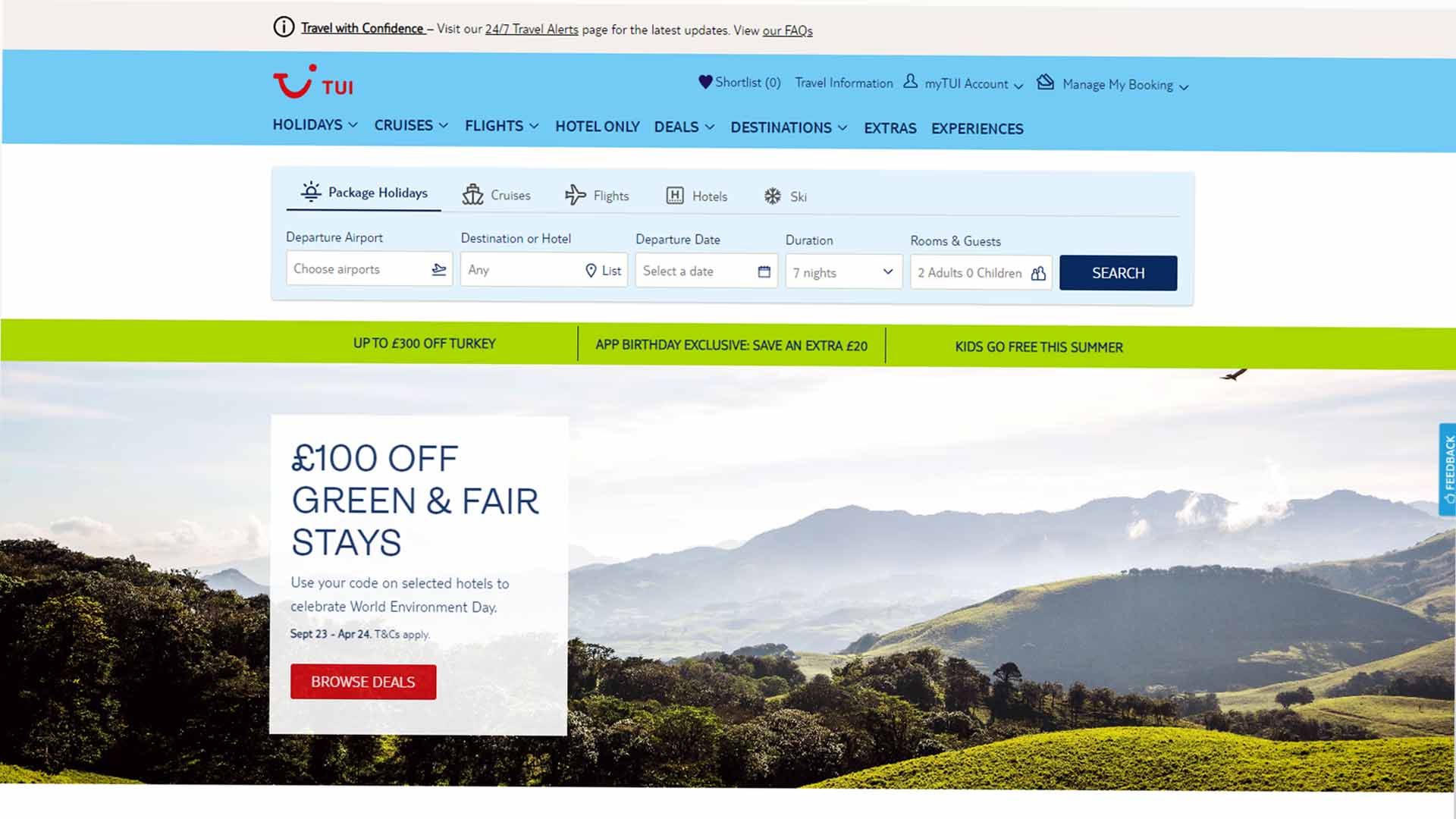
The ad copy itself is refreshingly simple yet impactful, conveying the essential message without overwhelming the reader. TUI has also leveraged a range of extensions to direct searchers directly to the specific information they are seeking, enhancing the user experience and making it easier for potential customers to find their ideal holiday options.
Additionally, for those who prefer an in-person experience, the ad even provides the convenience of two nearby physical locations.
What sets this Google search ad apart is its visual appeal. TUI Holidays has incorporated an eye-catching image that captivates the attention of users, further enhancing the overall impact and engagement of the ad.
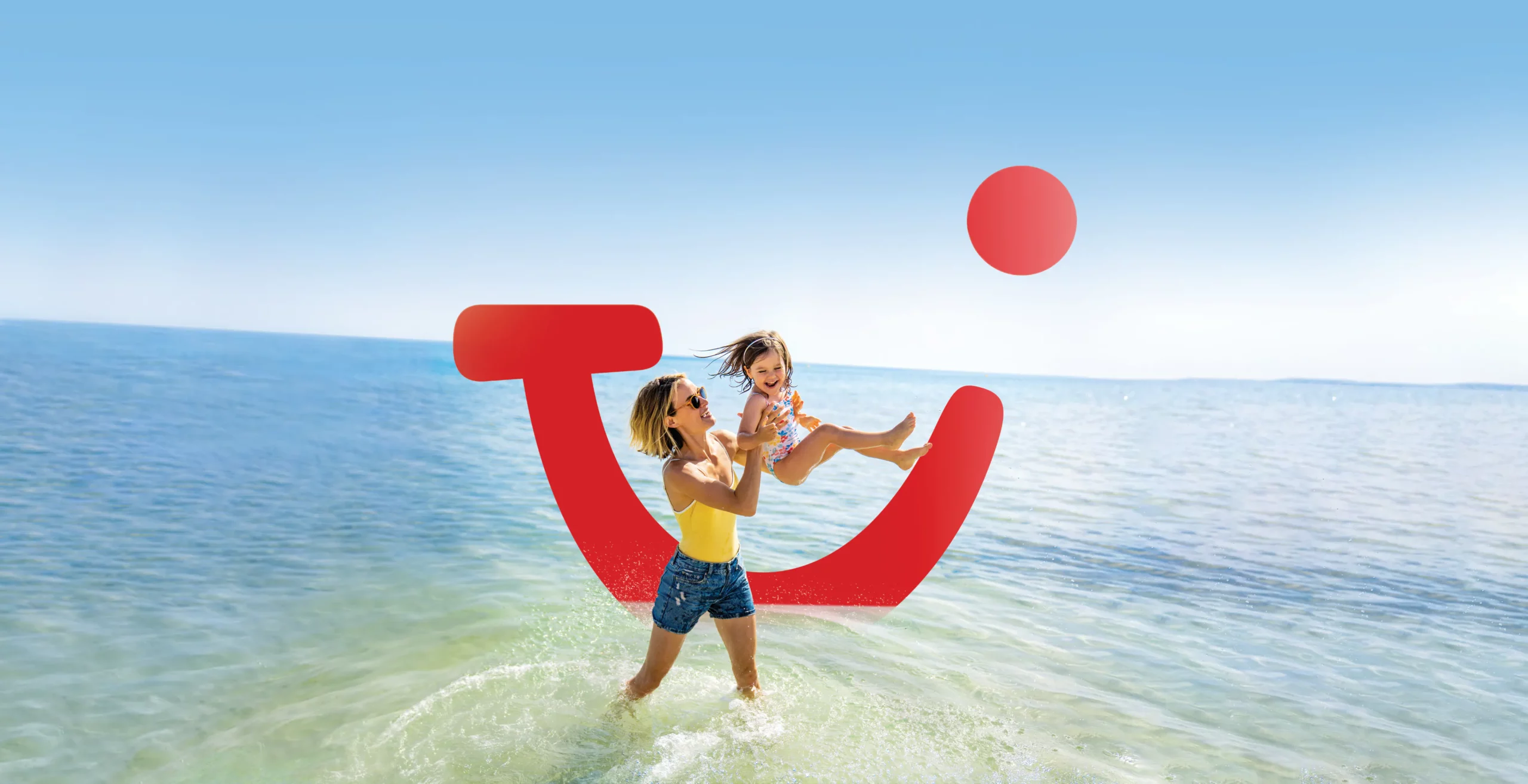
By combining a compelling headline, concise copy, targeted extensions, and an attention-grabbing image, TUI Holidays has created a search ad that stands out from the competition. This strategic approach not only captures the interest of potential customers searching for winter sun holidays but also provides a seamless user journey from search queries to browsing deals and potentially visiting a physical location.
TUI Holidays’ innovative use of features and visually appealing elements in their search ad exemplify their commitment to providing a user-centric experience and helping travellers find their dream holidays.
With this successful ad campaign, TUI Holidays effectively captures the attention of its target audience and positions itself as a leading choice for those seeking winter sun getaways.
Analyzing and Optimizing PPC Campaign Performance
To ensure the ongoing success of your PPC advertising campaigns, it’s crucial to analyze and optimize their performance. By monitoring key performance metrics, utilizing analytics tools, and conducting A/B testing, you can refine your campaigns and achieve better results.
Here are some key considerations:
Key performance metrics to measure campaign success
When analyzing your PPC campaign performance, it’s important to focus on key performance metrics that indicate the effectiveness of your ads and their impact on your business goals. Here are some metrics to consider:
- Click-through rate (CTR): This metric measures the percentage of users who click on your ads after seeing them. A high CTR indicates that your ad is relevant and compelling to your target audience.
- Conversion rate: The conversion rate measures the percentage of users who complete a desired action, such as making a purchase, filling out a form, or signing up for a newsletter. It reflects the effectiveness of your landing page and the alignment between your ad and the user’s expectations.
- Cost per click (CPC): The cost per click metric represents the average amount you pay for each click on your ads. By monitoring CPC, you can optimize your budget allocation and ensure that you’re getting the most value out of your advertising spend.
- Return on ad spend (ROAS): ROAS measures the revenue generated for every dollar spent on advertising. It helps you evaluate the profitability of your campaigns and make informed decisions about budget allocation.
- Quality score: Quality score is a metric used by search engines to assess the quality and relevance of your ads, keywords, and landing pages. It affects your ad rank and the cost per click. A higher quality score can lead to better ad placement and lower costs.
Utilizing analytics tools for data-driven insights and decision-making
To gain valuable insights into your PPC campaign performance, it’s essential to leverage analytics tools. Here are some tools that can help you track and analyze your campaigns:
- Google Analytics: Google Analytics provides in-depth data about user behaviour on your website, including the actions they take after clicking on your ads. It helps you understand the effectiveness of your landing pages, track conversions, and identify areas for improvement.
- Conversion tracking tools: Conversion tracking tools allow you to track specific actions users take on your websites, such as form submissions, purchases, or newsletter sign-ups. By implementing conversion tracking, you can measure the success of your campaigns and optimize your targeting and messaging.
- Heatmap analysis: Heatmap analysis tools provide visual representations of user interactions on your website, highlighting the areas that receive the most attention. This information can help you optimize your landing pages and improve user experience.
- Audience segmentation and behaviour analysis: By segmenting your audience based on demographics, interests, and behaviours, you can gain insights into the preferences and needs of different customer groups. This information can guide your ad targeting and messaging strategies.
A/B testing and continuous optimization to improve campaign performance
A/B testing involves creating multiple versions of your ads, landing pages, or other campaign elements and comparing their performance to determine the most effective approach.
Here are some areas where A/B testing can be beneficial:
- Testing different ad copies and visuals: Experiment with different headlines, ad copy variations, and visual elements to identify the messages and visuals that resonate most with your target audience.
- Experimenting with landing page designs: Test different layouts, calls to action, and content arrangements on your landing pages to optimize conversions and user experience.
- Adjusting bidding strategies and targeting options: Explore different bidding strategies, such as manual bidding or automated bidding, to find the most cost-effective approach. Test different targeting options, such as demographics or geographic targeting, to refine your audience reach.
- Refining keyword selection and match types: Continuously evaluate and optimize your keyword selection to ensure they align with your campaign goals. Test different match types, such as a broad match or exact match, to find the most effective keyword targeting strategy.
- By conducting A/B tests and continuously optimizing your PPC campaigns, you can uncover valuable insights, improve performance, and maximize your return on investment.
Best Practices for Effective PPC Advertising Business Campaigns
To ensure the success of your PPC advertising business campaigns, it’s important to follow best practices that maximize the impact of your efforts. By implementing these strategies, you can optimize your campaigns for better results and achieve your business goals.
1. Setting Clear Campaign Objectives and KPIs
Before launching a PPC advertising campaign, clearly define your objectives and establish measurable key performance indicators (KPIs).
Whether you aim to drive sales, generate leads, increase website traffic, or enhance brand awareness, setting specific goals will guide your strategy and help you evaluate success. Clearly defined objectives enable you to focus your efforts and track your progress effectively.
2. Conducting Comprehensive Keyword Research and Selection
Thorough keyword research is the foundation of a successful PPC campaign. Identify keywords that are relevant to your business, products, or services, and have a high search volume.
Use keyword research tools, such as Google Keyword Planner, to discover new keyword opportunities and analyze their competitiveness. Choose a mix of short-tail and long-tail keywords to capture different search intents and improve targeting.
3. Crafting Compelling Ad Copy and Creative
Creating persuasive and engaging ad copy is essential to attract the attention of your target audience.
Develop ad headlines that grab attention, highlight unique selling points, and communicate clear value propositions. Use compelling language, call-to-action phrases, and relevant keywords. Incorporate ad extensions, such as site links or call extensions, to provide additional information or drive specific actions.
Experiment with different variations of ad copy to determine what resonates best with your audience.
4. Implementing Effective Landing Pages
Optimize your landing pages to provide a seamless user experience and increase conversion rates. Ensure that your landing page aligns with the ad copy and delivers on the promised value proposition.
Keep the layout clean and uncluttered, with a clear call-to-action prominently displayed. Optimize page load times to minimize bounce rates. Test different landing page elements, such as headlines, images, and form fields, to optimize conversion rates and improve user engagement.
5. Targeting and Audience Segmentation
Use targeting options to reach your ideal audience and maximize the effectiveness of your PPC campaigns. Leverage demographic targeting, geographic targeting, and interest-based targeting to narrow down your audience and ensure your ads are shown to the right people.
Consider segmenting your audience based on specific criteria, such as age, location, or interests, and tailor your campaigns to each segment for better personalization and relevance.
6. Continuous Monitoring and Optimization
Regularly monitor the performance of your PPC campaigns to identify areas for improvement and capitalize on successful strategies. Keep a close eye on key performance metrics, such as click-through rate (CTR), conversion rate, and return on ad spend (ROAS).
Identify underperforming keywords or ads and make necessary adjustments. Conduct A/B testing to compare different ad variations, landing page layouts, or bidding strategies. By continuously optimizing your campaigns, you can enhance their effectiveness and drive better results.
7. Tracking and Analyzing Data
Take advantage of analytics tools to gain valuable insights into your PPC campaign performance. Use platforms like Google Analytics to track website traffic, conversions, and user behaviour.
Analyze data to identify trends, patterns, and opportunities. Use the information to refine your targeting, optimize keyword bids, and make data-driven decisions for campaign improvements. Regularly review performance reports and adjust your strategy accordingly.
8. Adhering to Budgeting and Bid Management Strategies
Allocate your budget strategically across different campaigns, ad groups, and keywords. Set daily or monthly budget caps to ensure you stay within your desired spending limits.
Implement bid management strategies to optimize your ad spend and maximize ROI. Regularly review keyword bids, adjust them based on performance and competition, and leverage automated bidding tools when appropriate.
Continuously monitor your budget and bids to ensure they align with your campaign objectives.
9. Staying Up-to-Date with Industry Trends and Innovations
The digital advertising landscape is constantly evolving, so it’s important to stay informed about industry trends, innovations, and new features offered by PPC advertising platforms. Attend industry conferences, read industry publications, and follow reputable digital marketing blogs to stay up-to-date.
Embrace new technologies and tactics that can enhance the effectiveness of your campaigns and give you a competitive edge.
10. Seeking Expert Assistance
PPC advertising can be complex, especially for businesses with limited resources or expertise in digital marketing. Consider seeking expert assistance from PPC advertising agencies or consultants who specialize in optimizing campaigns for business growth.
Their expertise and experience can help you navigate the intricacies of PPC advertising, maximize your results, and save time and resources.
Grow with PPC
PPC advertising has emerged as a game-changing strategy for business campaigns, offering a plethora of benefits that can propel your brand to new heights. With immediate visibility, targeted advertising, cost control, measurable results, and enhanced brand exposure, PPC advertising empowers you to reach your audience effectively and drive impactful outcomes.
At The Brand Shop, we understand the power of PPC advertising and its potential to transform your business. Our team of seasoned brand experts and digital marketers is ready to guide you through the intricacies of PPC advertising and help you craft compelling campaigns that drive tangible results.
Don’t miss out on the opportunities that PPC advertising presents. Take the next step in elevating your business campaigns by partnering with The Brand Shop.
Contact us today to schedule a consultation and discover how we can leverage PPC advertising to fuel your business growth and achieve remarkable success.




